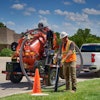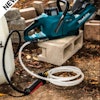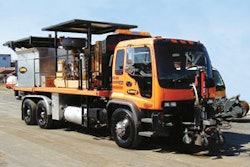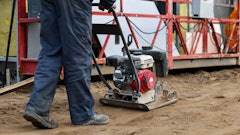Light compaction equipment is fairly simple in concept. You turn on a rammer, plate or trench compactor, the machine’s vibration settles the soil until it’s stable and that’s the end of the story. Right?
Yes and no. It’s true the concept of compaction is simple at face value, but proper and productive operation of rammers, plates and trench compactors is more complex and deserves a healthy dose of respect.
While there are many pieces of equipment that are more obvious in their hazard potential -- the humble chainsaw comes to mind immediately -- light compaction does involve a relatively heavy machine vibrating at high frequency to pound the earth into submission. Let’s just say you wouldn’t want a body part to get in the way of that action.
The basics
Whether your customer is renting a rammer, plate or trench compactor, there are certain rules that apply in all cases. Renters of light compaction equipment should always be supplied with an operator’s manual for the specific piece of equipment they’re renting.
Furthermore, they should be strongly encouraged to read and understand the material. “From a performance and safety standpoint, this is the number one priority,” says Peter Price, product manager with Bomag Light Equipment.
In addition to supplying the owner’s manual, rental personnel should ensure that the machine has all of the necessary safety decals and that they are clearly legible. While it might sound trite, this is an important step toward ensuring the safety of customers. As Price states, “complacency kills.”
When renting a piece of equipment, always be sure to ask the renter exactly what he or she is planning to do with it. Often, a renter will have used one type of equipment for a job in the past and will think that’s what they need for their current project. Knowing what type of soil the operator will be working in is crucial to steering that person toward the right piece of equipment. Using a rammer in granular soil, for example, won’t yield optimum results and could result in a dissatisfied customer, not to mention personal injury or property damage.
Avoid run--away rammers
Rammers are intended for use in cohesive soils, but everyone knows that users occasionally use them to compact asphalt patches and so on. While the machine isn’t intended for this type of use, it will do the job. It’s unconventional tasks like this, however, that create the biggest potential for accidents.
Rammer safety starts with turning the machine on properly. According to Frank Wenzel, vice president of engineering at Stone Construction Equipment, it’s important to be sure the throttle is in the idle position before turning the machine on. Otherwise, the rammer could begin hopping before the operator is ready.
“A novice user might want to give it some throttle to get it to start,” he explains. “But you should only run the rammer at idle or full speed. Anywhere in between could cause the machine to ‘hit a harmonic.’ This is an incorrect compression and frequency rhythm which can make the machine run erratically, jump higher or become unsteady.”
Technique is another consideration. Novice users often try too hard to “manhandle” or force the machine during operation, Price points out. “People try to force the machine up on a grade or down a hill which can bog it down,” he says, adding, “When you manhandle the machine, often you have to take your hand off the throttle control and then you can’t react fast enough to turn the machine off, if need be. Let the machine do the work. Just guide it.”
According to Mark Diodato, light construction product specialist with Ingersoll--Rand, a self-balancing feature like that used on I--R rammers is particularly helpful to unseasoned operators. “We’ve repositioned the orientation of the eccentric weight so that it’s constantly rotating; it’s spinning more uniformly in such a way that balances the rammer. It’s self--walking.”
Of course, it’s always important to know when to say when. Veteran users of light compaction equipment can ‘feel’ when the material they’re working reaches maximum density. As the material gets harder, the [rammer] gets more erratic. The forces of compaction go elsewhere besides into the ground, such as back into the machine and through to the operator.
Today’s rammers are designed to be ergonomic, reducing the vibrations felt by the operator. While this is a boon to the long-term productivity and comfort of the operator, vibration isolation can make it more difficult to determine when optimum soil density has been achieved.
“With reduced hand/arm vibration, people don’t feel the work as much and they can tend to over compact the soil,” Price explains. “Over time, you get a feel for compaction density. If you follow the manufacturer’s guidelines, you will achieve optimum density.”
Play it safe with plates
Forward and reversible plate compactors are a bit more tame than rammers, but safety is still a top priority. Because of the lower amplitude--these machines don’t jump as high as rammers do-- there’s less potential for losing control.
As with rammers, plates should be started with the throttle in the idle position. Also, Wenzel suggests, it’s best to start the machine in a clear, unobstructed area.
Accidental starting with the throttle in forward could result in damage to any nearby obstacles.
While personal injury is less likely when using a plate compactor, property damage is still a concern, particularly for the novice user. Weekend warriors, for example, frequently rent plates to install patio blocks. In a case like this, choosing the right equipment for the job as well as high-quality materials is crucial to the success of the project. Price notes that Bomag offers a neoprene mat that can be installed on its plates to create a softer blow which can prevent stones from being damaged. Likewise, I-R offers a combination plate that uses rubber rollers that are safe for use on decorative stones.
“The main thing is to know your surroundings,” says Price. “Don’t compact right up against a foundation wall, leave room for corners, consider the placement of water and gas lines. With larger, reversible plates, it becomes very important to know what’s underground.”
He adds, “Use the guide handle. Don’t try to pull the machine sideways; don’t turn to make sharp corners unreasonably... If you can’t turn comfortably, then shut down the machine and turn it manually.”
Wenzel points out that like rammers, plates can operate erratically when the soil reaches optimum compaction. “When you achieve 100-percent density in the soil, the ground becomes harder and stiffer and the compactive force starts to come back to the operator, making the machine more difficult to hold onto. This is normal, but an inexperienced operator might be surprised and think something’s wrong.”
In the trenches
With trench compactors, the biggest hazard potential is the trench itself. Manufacturers today offer remote control operation of their trench compactors, so users don’t have to be anywhere near the trench during operation. It’s important to note, however, that the area near the edge of a trench can be unstable, so it’s best for operators to position themselves as far away from the trench as possible while keeping the machine clearly within sight. It’s important to be able to see any obstacles or bystanders in the area.
Also, consider the gradeability of the machine.
Manufacturers typically recommend a certain grade limit that should not be exceeded. “Be aware of the machine’s limitations,” Price says. “No matter what’s published in the manual, consider your surroundings.”
Also, ensure your customer is confident with the controls on the machine. Wenzel says accidents are much more likely if the operator is unable to quickly turn the machine off or steer it away from an obstacle or person in its path. “You need to be able to react properly and quickly,” he states. “As with all pieces of equipment, the first thing you should know is how to turn the machine off.”
Diodato adds, “Ease of use is key.”
The science of compaction
There is definitely a scientific formula for effective soil compaction. One must consider such factors as the type of soil (cohesive or granular), its moisture content, the looseness of the particles and the temperature, etc. in order to achieve maximum productivity and optimum machine performance.
Unfortunately, many of the people using equipment don’t have extensive knowledge of the finer points of compaction science. For this reason, it’s important for your employees-- particularly your counter and delivery personnel -- to be knowledgeable and able to confidently instruct and demonstrate the equipment to inexperienced operators.
According to Price, the best advice to give to renters of light compaction equipment can be summed up like this: “Use common sense and don’t become complacent. Accidents can happen in a split second, so don’t take risks or shortcuts. They can be life threatening.”



















